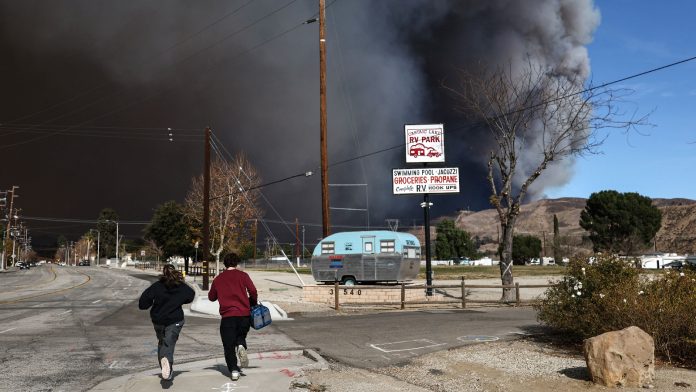Early January usually falls smack in the middle of Los Angeles County’s rainy season. The moisture coaxes the browned landscape into hues of green, but that was not the case in 2024. Just 0.16 inches of rain fell downtown during the last six months of the year, nearly four inches below normal for the area. From July to October, no measurable rain fell at all.
Conditions were ripe for ignition. Parched sagebrush provided tinder for fires large enough to engulf trees, homes, and entire communities. On January 7, 2025, the Palisades fire erupted in the canyons outside of Malibu. A few hours later, the Eaton Fire ignited in the sprawling national forest lands north of Downtown Los Angeles.
Eight more fires broke out in L.A. County that month while firefighters worked to put out the largest of the blazes.
Fueled by severe Santa Ana winds and prolonged drought conditions, the wildfires collectively scorched over 40,000 acres, destroyed more than 15,000 structures, and claimed at least 28 lives. Millions were exposed to toxic smoke.
“It was smoke all around us, fires everywhere,” Kelsey Trainor, an attorney who lives in Pacific Palisades, told NBC News.
A growing health threat
The impact of wildfire smoke on people has changed rapidly over the last century. Rapid expansion of housing developments into landscapes that naturally burn, coupled with climate change, created the perfect storm. More people are exposed to dangerous air quality during wildfires that are increasingly more extreme.
Around 44 million people around the world are exposed to unhealthy air quality every year due to wildfires alone, according to a recent paper published in the peer-reviewed journal Atmospheric Environment. An additional 4 million people have at least one day of exposure to air quality considered hazardous to health.
These exposures, the researchers estimated, cause more than 670,000 premature deaths annually, more than one-third among women and young children. Vulnerable communities, including the elderly, children, those with health comorbidities, and outdoor workers in agriculture, construction, and natural resource management, often face higher rates of smoke exposure. So, balancing human and forest health is increasingly a dilemma for forest managers.
A history of suppression
Fire played a critical role in forest health throughout the American West, long before people moved there in droves.
At the right frequency and intensity – two factors becoming increasingly volatile – fire can clear undergrowth and make way for new plants, maintaining a healthy balance of biodiversity. With the colonization of the U.S., fire exclusion and suppression became the norm, leading to a buildup of fuels on the forest floor.
Only in recent years have forest management strategies started to shift back toward the use of fire as a tool, but there is still a long way to go.
One-third of U.S. homes are now built in the wildland-urban interface, or WUI, areas near or on land prone to wildfire. In just 20 years, WUI areas grew by more than 46 million acres, according to U.S. Forest Service data. It’s the fastest-growing land use type in the continental U.S. and already covers an area larger than Washington State. As homes creep into forestland, people perceive necessary prescribed burns as a threat rather than a strategy to prevent larger wildfires from breaking out.
Instead of strategically burning sections of forest as is done with prescribed burning, wildland managers are forced to rely on forest thinning – removing brush and selecting trees to reduce the amount of wildfire fodder a forest harbors. To protect homes when a wildfire does break out, firefighters are pressured to rapidly suppress fire rather than let it run its course.
Combined with climate change, this shift in forest management has caused wildfires to have more severe impacts on both the environment and humans. In a 2024 publication in Nature Communications, researchers discuss the fallout of what they call the “fire suppression paradox” – by suppressing fires today, we make fires harder to put out in the future. Without regular cycles of fire, forests become denser and more uniform, paving the way for large-scale, high-intensity fires that are extremely difficult to suppress.
In recent years, it’s become clear that a suppression-only approach is not sustainable. More land managers are pivoting to a more mixed approach, which the authors of the 2024 study call “progressive suppression.” This includes using a few techniques together, including thinning forests, restoring ecosystems, and reinstating prescribed burns.
The study’s model showed this approach would make forests more resilient to climate change. And while a mixed approach to fire mitigation that includes prescribed burns would not stop all high-intensity, destructive fires from taking hold, it would curtail some. These findings were echoed in a 2024 Forest Ecology and Management meta-analysis and a 2024 study published in Fire Ecology.
Human health tradeoffs
It’s understood that logging and fire suppression are inferior forest management techniques compared to prescribed burning, but some public health advocates argue the hazards additional wildfire smoke poses to human health need to be part of the equation.
Wildfire smoke is linked to eye, nose, and throat irritation, as well as serious health effects, including respiratory distress, heart failure, and premature death, according to the Environmental Protection Agency.
A 2023 meta-analysis published in the journal Neurology found that just five days of exposure to high levels of pollution can raise a person’s risk of stroke by as much as 30%, depending on which toxins are in the air.
“Air pollution’s impact on human health extends beyond the lungs and eyes. It also involves the brain and cardiovascular system,” Dr. Ahmad Tubasi, a researcher with the faculty of medicine at the University of Jordan, told NBC News.
Some public health experts worry that smoke from prescribed burns adds to the number of days people are exposed to poor air quality because of fires. The reality may be more complicated.
In an analysis published in 2023 in Nature Sustainability, researchers found that compared to a strategy of thinning 16,000 hectares per year of forest alone, adding in moderate prescribed burning was the best strategy for reducing wildfire smoke exposure for people nearby when wildfire does break out, while also minimizing extra smoke exposure from prescribed burns. Combining the methods also shrank wildfire season by about a month.
Some of the disconnect between health and forest experts can be attributed to the timelines on which they work. Smoke exposure can negatively affect human health within just a couple of days or even hours, a consideration that health experts focus on. On the other hand, ecologists and forest managers have to think on a broader timeline, preparing wildlands for years and decades into the future.
Finding a happy medium
Striking a balance between these schools of thought is not a zero-sum game. There are many air quality regulations in place that limit the amount and scale of prescribed burning across the US. Forest managers often carry out prescribed burns in areas far from communities and during weather conditions that send the smoke straight up rather than carry it into the lungs of people. Even these far away burns must be permitted and approved by air quality agencies on the day of the burn.
To protect communities from tragic wildfires, managers need to carry out more prescribed burns closer to the places people live. Being prepared for this predictable surge of smoke can help people living in fire-prone communities protect themselves against its harmful health effects.
Improving warning systems and giving people tools to create smoke-ready spaces could reduce health impacts. An important piece of this puzzle is pinning down whose responsibility this is. Federal agencies have already gotten started.
The CAIF report, which officials released based on 2020 data, set clear guidelines that tasked the EPA, Forest Service, Department of the Interior, and National Institute of Standards and Technology with their responsibilities for protecting communities from wildfire smoke while allowing forest managers to use the best forest management techniques possible. The report also underscored the need for the agencies to conduct additional research to develop a clearer, shared understanding of the problem.
“These areas of additional research include enhanced air quality monitoring capabilities for wildfire smoke, better characterization of wildland fire smoke exposures for health studies, additional understanding of the health effects of wildfire smoke over many seasons, and a fuller accounting for the role of public health actions and interventions in reducing or mitigating wildland fire smoke exposure,” the report stated.
However, the efforts may be in peril. On March 12, EPA Administrator Lee Zeldin released the agency’s plans to strip back air quality protections that would make it easier for wildland managers to do more prescribed burns. The Trump Administration has also made huge funding and staffing cuts on both the human health and environmental research sides.
In 2023, the Biden Administration released a Memo of Understanding aimed at agencies that handle forestry – the U.S. Department of Agriculture, the EPA, and the U.S. Department of the Interior – and the Centers for Disease Control and Prevention.
Collaboration between these agencies included community engagement that helped people prepare for smoke exposure by creating “Smoke-Ready Communities” using EPA instruction.
This includes understanding who makes up the most vulnerable communities before wildfires or prescribed burns happen and preparing communities with instructions on how to create clean air rooms, knowing their risk, stocking up on medications, and preparing for a potential evacuation.
“The increasing frequency and magnitude of wildfires pose an ever-growing threat to the health of the American public,” said Dr. Mandy Cohen, former director of the Centers for Disease Control and Prevention, in the federal memo.
Savannah D’Evelyn is an environmental health scientist and bio-social scientist at the University of Washington. Kaitlin Sullivan is a freelance journalist. She covers health, science, and the environment. This article was produced in partnership with Energy Innovation and the Aspen Global Change Institute. Both organizations are Yale Climate Connections content-sharing partners.
This story is part of The 89 Percent Project, an initiative of the global journalism collaboration Covering Climate Now.




